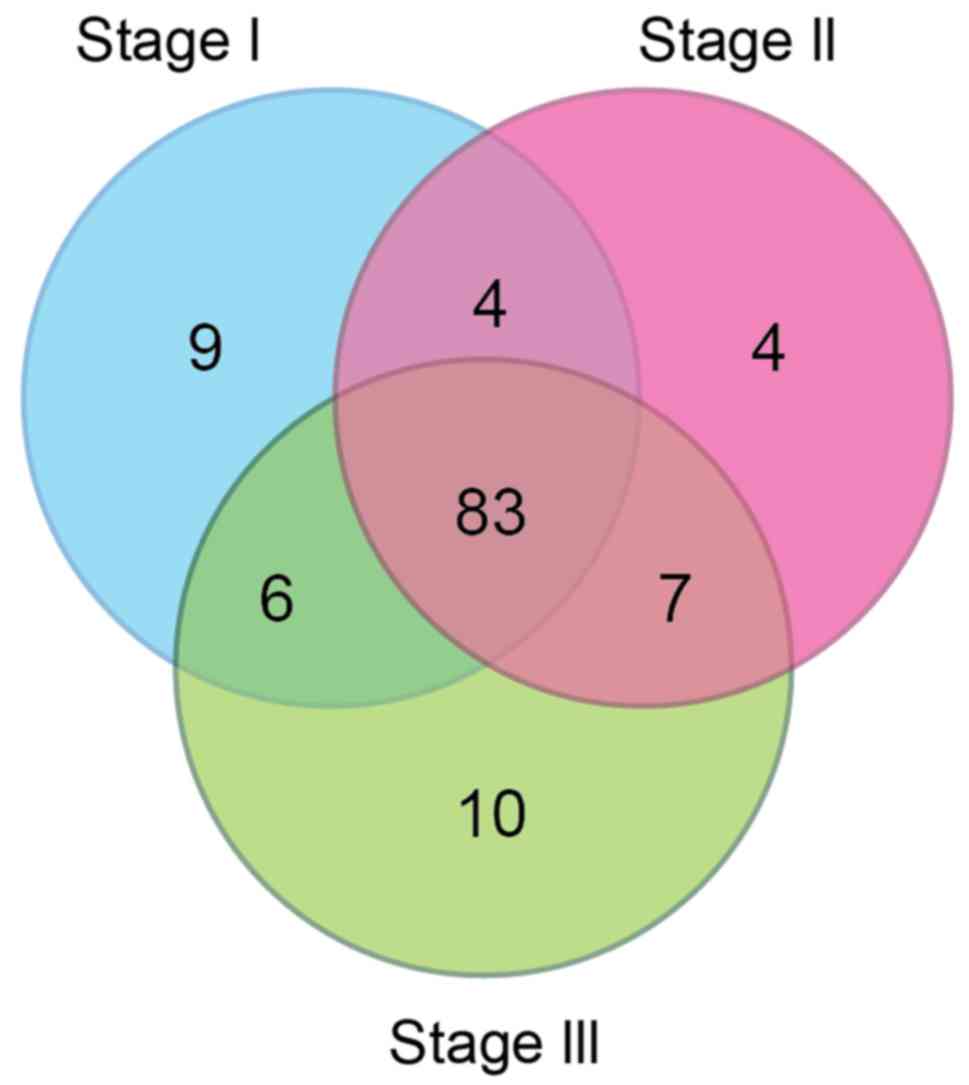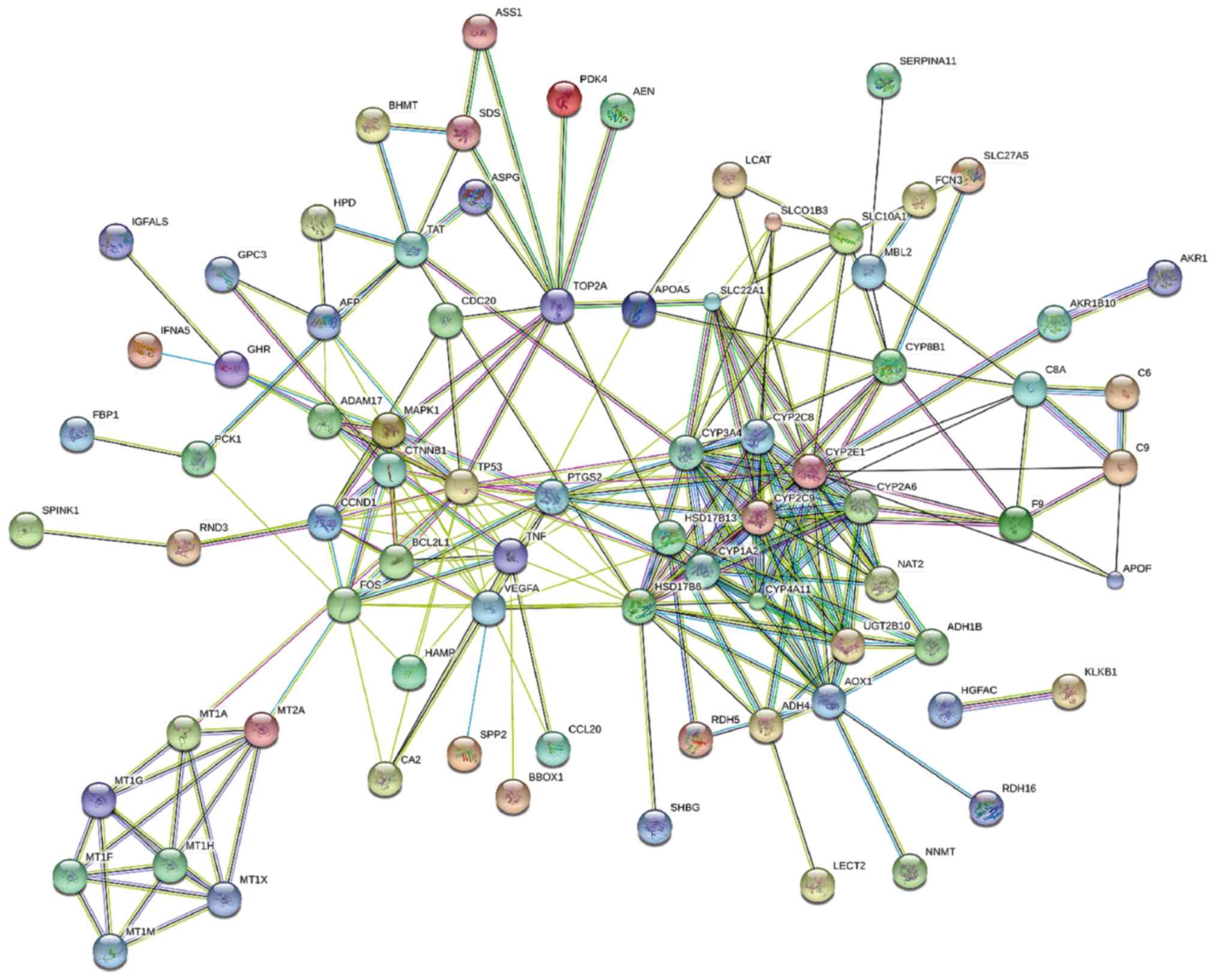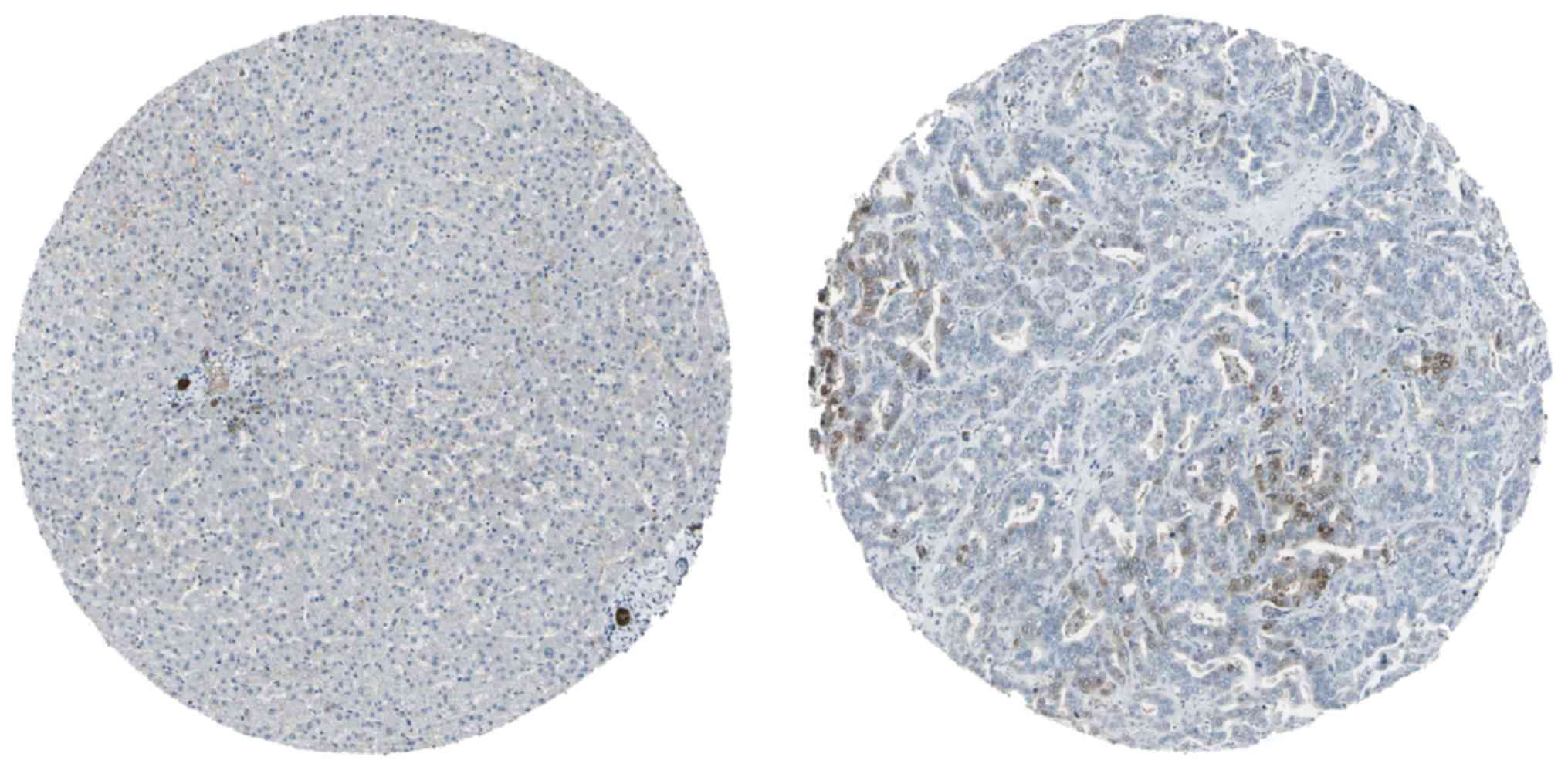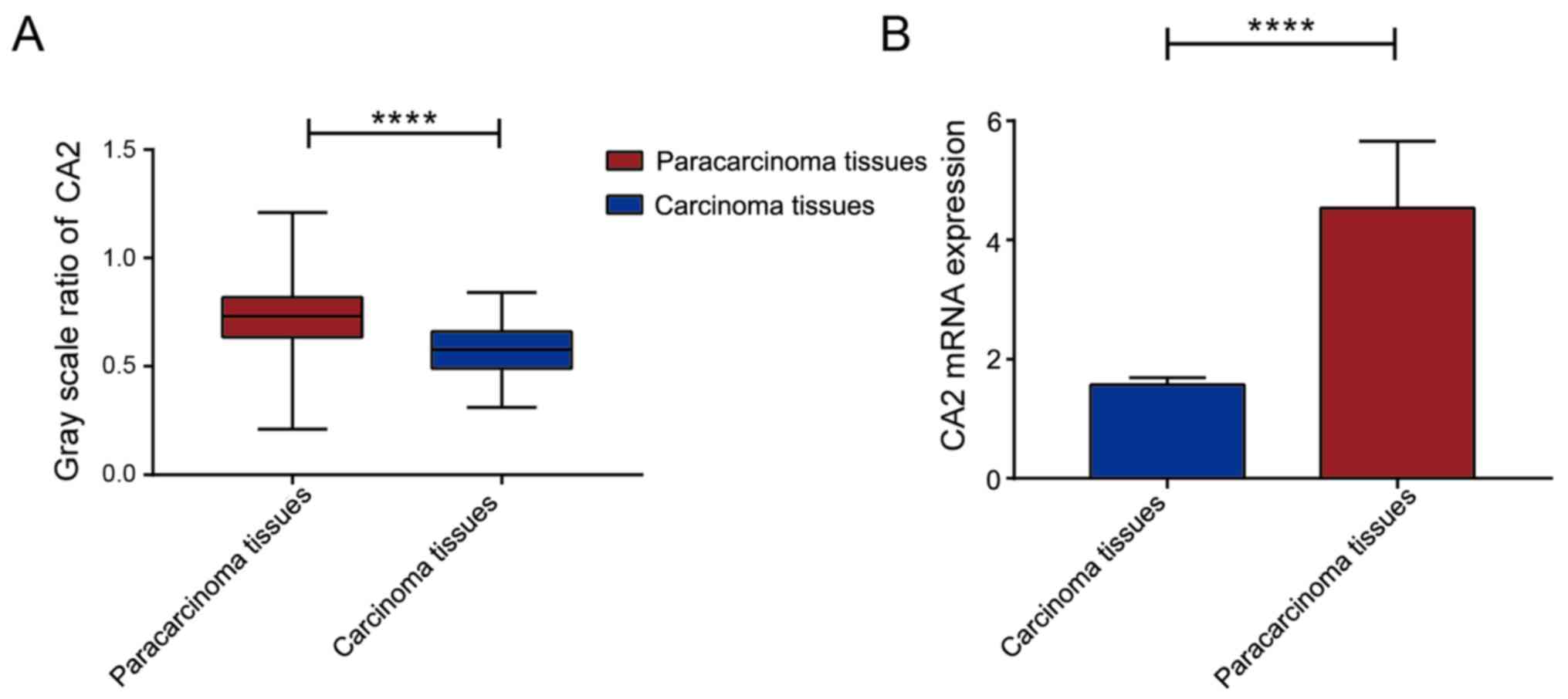|
1
|
Kumar N, Biswas S, Mathew AE, Varghese S,
Mathew JE, Nandakumar K, Aranjani JM and Lobo R: Pro-apoptotic and
cytotoxic effects of enriched fraction of Elytranthe
parasitica (L.) Danser against HepG2 Hepatocellular carcinoma.
BMC Complement Altern Med. 16:4202016. View Article : Google Scholar : PubMed/NCBI
|
|
2
|
Pan Q, Long X, Song L, Zhao D, Li X, Li D,
Li M, Zhou J, Tang X, Ren H, et al: Transcriptome sequencing
identified hub genes for hepatocellular carcinoma by weighted-gene
co-expression analysis. Oncotarget. 7:38487–38499. 2016. View Article : Google Scholar : PubMed/NCBI
|
|
3
|
Fathy SA, Emam MA, Abo Agwa SH, Abu Zahra
FA, Youssef FS and Sami RM: The antiproliferative effect of
Origanum majorana on human hepatocarcinoma cell line: Suppression
of NF-κB. Cell Mol Biol. 62:80–84. 2016.PubMed/NCBI
|
|
4
|
Jayachandran A, Dhungel B and Steel JC:
Epithelial-to-mesenchymal plasticity of cancer stem cells:
Therapeutic targets in hepatocellular carcinoma. J Hematol Oncol.
9:742016. View Article : Google Scholar : PubMed/NCBI
|
|
5
|
Shen J, Jiang F, Yang Y, Huang G, Pu F,
Liu Q, Chen L, Ju L, Lu M, Zhou F, et al: 14-3-3η is a novel
growth-promoting and angiogenic factor in hepatocellular carcinoma.
J Hepatol. 65:953–962. 2016. View Article : Google Scholar : PubMed/NCBI
|
|
6
|
Zhang Y, Chen XM and Sun DL: Short-term
outcomes of laparoscopic versus open right hemihepatectomy for
hepatocellular carcinoma. Surg Laparosc Endosc Percutan Tech.
26:e157–e160. 2016. View Article : Google Scholar : PubMed/NCBI
|
|
7
|
Cheng S, Wei X and Wu M: Effective ways to
improve the prognosis of advanced stage (BCLC stage C)
hepatocellular carcinoma. Zhonghua Wai Ke Za Zhi. 53:324–327.
2015.(In Chinese). PubMed/NCBI
|
|
8
|
Yang J, Jin X, Yan Y, Shao Y, Pan Y,
Roberts LR, Zhang J, Huang H and Jiang J: Inhibiting histone
deacetylases suppresses glucose metabolism and hepatocellular
carcinoma growth by restoring FBP1 expression. Sci Rep.
7:438642017. View Article : Google Scholar : PubMed/NCBI
|
|
9
|
Ehsani Ardakani MJ, Safaei A, Arefi
Oskouie A, Haghparast H, Haghazali M, Mohaghegh Shalmani H,
Peyvandi H, Naderi N and Zali MR: Evaluation of liver cirrhosis and
hepatocellular carcinoma using Protein-Protein Interaction
Networks. Gastroenterol Hepatol Bed Bench. 9 (Suppl 1):S14–S22.
2016.PubMed/NCBI
|
|
10
|
Menteşe A, Erkut N, Demir S, Özer Yaman S,
Sümer A, Doğramacı Ş, Alver A and Sönmez M: Autoantibodies against
carbonic anhydrase I and II in patients with acute myeloid
leukemia. Turk J Haematol. 34:307–313. 2017.PubMed/NCBI
|
|
11
|
Sheng WW, Dong M, Zhou JP, Kong FM and Li
YJ: Clinicopathological significance of the expression of carbonic
anhydrase I and II in human pancreatic cancer. Zhonghua Yi Xue Za
Zhi. 92:3407–3411. 2012.(In Chinese). PubMed/NCBI
|
|
12
|
Viikilä P, Kivelä AJ, Mustonen H,
Koskensalo S, Waheed A, Sly WS, Pastorek J, Pastorekova S, Parkkila
S and Haglund C: Carbonic anhydrase enzymes II, VII, IX and XII in
colorectal carcinomas. World J Gastroenterol. 22:8168–8177. 2016.
View Article : Google Scholar : PubMed/NCBI
|
|
13
|
Hu X, Huang Z, Liao Z, He C and Fang X:
Low CA II expression is associated with tumor aggressiveness and
poor prognosis in gastric cancer patients. Int J Clin Exp Pathol.
7:6716–6724. 2014.PubMed/NCBI
|
|
14
|
Järvinen P, Kivelä AJ, Nummela P, Lepistö
A, Ristimäki A and Parkkila S: Carbonic anhydrase II: A novel
biomarker for pseudomyxoma peritonei. APMIS. 125:207–212. 2017.
View Article : Google Scholar : PubMed/NCBI
|
|
15
|
Wang Y, Jiang T, Li Z, Lu L, Zhang R,
Zhang D, Wang X and Tan J: Analysis of differentially co-expressed
genes based on microarray data of hepatocellular carcinoma.
Neoplasma. 64:216–221. 2017. View Article : Google Scholar : PubMed/NCBI
|
|
16
|
Hass HG, Vogel U, Scheurlen M and Jobst J:
Gene-expression analysis identifies specific patterns of
dysregulated molecular pathways and genetic subgroups of human
hepatocellular carcinoma. Anticancer Res. 36:5087–5095. 2016.
View Article : Google Scholar : PubMed/NCBI
|
|
17
|
Wang J, Liu F, Ao P, Li X, Zheng H, Wu D,
Zhang N, She J, Yuan J and Wu X: Correlation of PDK1 expression
with clinicopathologic features and prognosis of hepatocellular
carcinoma. OncoTargets Ther. 9:5597–5602. 2016. View Article : Google Scholar
|
|
18
|
Edge SB and Compton CC: The American Joint
Committee on Cancer: The 7th edition of the AJCC cancer staging
manual and the future of TNM. Ann Surg Oncol. 17:1471–1474. 2010.
View Article : Google Scholar : PubMed/NCBI
|
|
19
|
Livak KJ and Schmittgen TD: Analysis of
relative gene expression data using real-time quantitative PCR and
the 2−ΔΔCT method. Methods. 25:402–408. 2001.
View Article : Google Scholar : PubMed/NCBI
|
|
20
|
Kai K, Koga H, Aishima S, Kawaguchi A,
Yamaji K, Ide T, Ueda J and Noshiro H: Impact of smoking habit on
surgical outcomes in non-B non-C patients with curative resection
for hepatocellular carcinoma. World J Gastroenterol. 23:1397–1405.
2017. View Article : Google Scholar : PubMed/NCBI
|
|
21
|
Liang R, Lin Y, Ye JZ, Yan XX, Liu ZH, Li
YQ, Luo XL and Ye HH: High expression of RBM8A predicts poor
patient prognosis and promotes tumor progression in hepatocellular
carcinoma. Oncol Rep. 37:2167–2176. 2017. View Article : Google Scholar : PubMed/NCBI
|
|
22
|
Du Z, Niu S, Xu X and Xu Q:
MicroRNA31-NDRG3 regulation axes are essential for hepatocellular
carcinoma survival and drug resistance. Cancer Biomark. 19:221–230.
2017. View Article : Google Scholar : PubMed/NCBI
|
|
23
|
Li F and Liu W: Genome-wide
identification, classification, and functional analysis of the
basic helix-loop-helix transcription factors in the cattle, Bos
Taurus. Mamm Genome. 28:176–197. 2017. View Article : Google Scholar : PubMed/NCBI
|
|
24
|
Shangguan H, Tan SY and Zhang JR:
Bioinformatics analysis of gene expression profiles in
hepatocellular carcinoma. Eur Rev Med Pharmacol Sci. 19:2054–2061.
2015.PubMed/NCBI
|
|
25
|
Liu M, Dou Y, Sun R, Zhang Y and Liu Y:
Molecular mechanisms for alcoholic hepatitis based on analysis of
gene expression profile. Hepat Mont. 15:e273362015.
|
|
26
|
Poortahmasebi V, Poorebrahim M, Najafi S,
Jazayeri SM, Alavian SM, Arab SS, Ghavami S, Alavian SE, Rezaei
Moghadam A and Amiri M: How hepatitis C virus leads to
hepatocellular carcinoma: A network-based study. Hepat Mont.
16:e360052016.
|
|
27
|
Gokcen T, Gulcin I, Ozturk T and Goren AC:
A class of sulfonamides as carbonic anhydrase I and II inhibitors.
J Enzyme Inhib Med Chem. 31:180–188. 2016. View Article : Google Scholar : PubMed/NCBI
|
|
28
|
Fares M, Eladwy RA, Nocentini A, El Hadi
SRA, Ghabbour HA, Abdel-Megeed A, Eldehna WM, Abdel-Aziz HA and
Supuran CT: Synthesis of bulky-tailed sulfonamides incorporating
pyrido[2,3-d][1,2,4]triazolo[4,3-a]pyrimidin-1(5H)-yl)
moieties and evaluation of their carbonic anhydrases I, II, IV and
IX inhibitory effects. Bioorg Med Chem. 25:2210–2217. 2017.
View Article : Google Scholar : PubMed/NCBI
|
|
29
|
Tian MM, Fan YC, Zhao J, Gao S, Zhao ZH,
Chen LY and Wang K: Hepatocellular carcinoma suppressor 1 promoter
hypermethylation in serum. A diagnostic and prognostic study in
hepatitis B. Clin Res Hepatol Gastroenterol. 41:171–180. 2017.
View Article : Google Scholar : PubMed/NCBI
|
|
30
|
Leung TW, Tang AM, Zee B, Lau WY, Lai PB,
Leung KL, Lau JT, Yu SC and Johnson PJ: Construction of the Chinese
University Prognostic Index for hepatocellular carcinoma and
comparison with the TNM staging system, the Okuda staging system,
and the cancer of the liver Italian Program staging system: A study
based on 926 patients. Cancer. 94:1760–1769. 2002. View Article : Google Scholar : PubMed/NCBI
|














